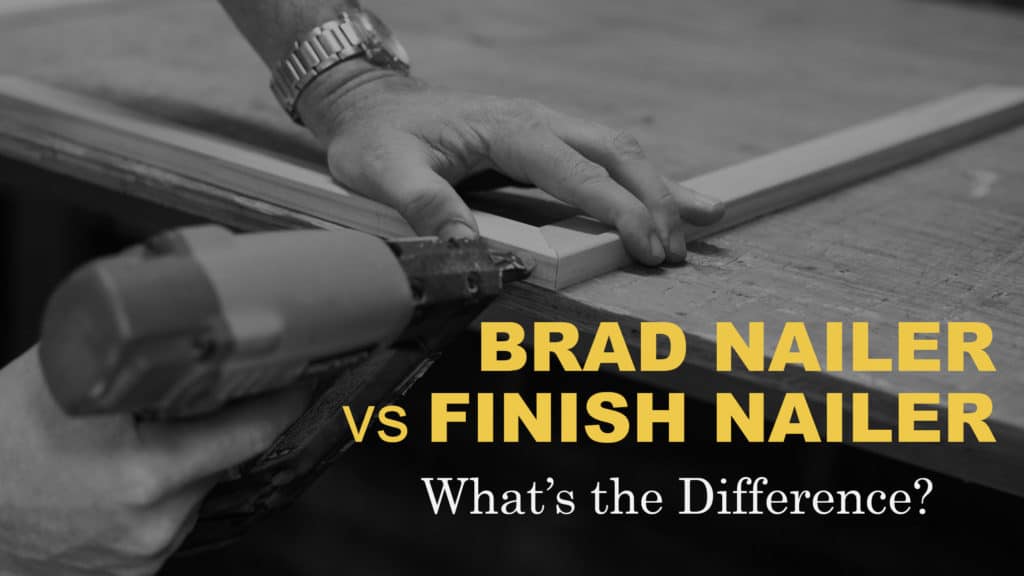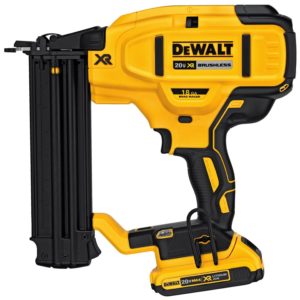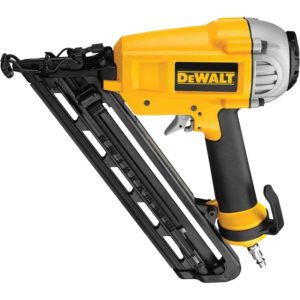If you’re anything like me, you can easily get overwhelmed by all the different types of nail guns out there. Just trying to figure out which finishing nailer is best, a brad nailer vs. finish nailer, for what you need to do, can be a job itself.
When I was remodeling my house, I got to the point where I needed to install some baseboard and door trim. I knew that I wanted to use a nail gun to help speed up the process, but I didn’t know whether I should use a brad nailer or a finish nailer.
Is there really a difference between the two?
They both look very similar and seem to accomplish much of the same tasks.
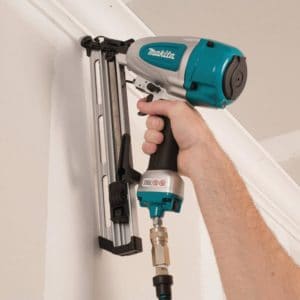
When you stop and think about it, all tools have a distinct purpose, and are designed to accomplish specific jobs.
Yes, I know…some tools can be used for multiple types of jobs, like how you can use a wrench to hammer a nail, but is that really the best use of that tool?
As it turns out, brad nailers are better at certain jobs more than finish nailers, and vice versa.
To help clear things up, let’s take a closer look at these two tools and try to get a better understanding about what they’re designed to do, and what the differences between a brad nailer and a finish nailer really are.
When all’s said and done, I want to be able to help you decide which nailer is right for the job you need to accomplish.
Let’s Dive Right In
- What Is a Brad Nailer?
- What’s a Brad Nail Gun Used For?
- Advantages of Brad Nailers
- Disadvantages of Brad Nailers
- Pneumatic vs. Cordless Brad Nailer
- Can You Use Finish Nails in a Brad Nailer?
- How to Use a Brad Nailer
- What Is a Finish Nailer?
- What’s a Finish Nail Gun Used For?
- Advantages of Finish Nailers
- Disadvantages of Finish Nailers
- 16 Gauge vs 15 Gauge Finish Nailer
- How to Use a Finish Nailer
- Summary
- FAQs
ToolLogic.com earns a commission from purchases made through links in this post. Learn More
What Is a Brad Nailer?
A brad nailer is basically the smaller cousin of a finish nailer.
It’s designed to be a lightweight, easy to use nail gun, that can shoot brad nails. Brad nails are thinner and have a smaller head compared to standard finish nails.
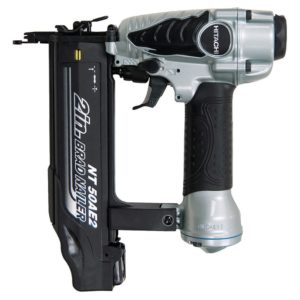
Since the brads are smaller in size, a brad nailer doesn’t require as much force to shoot nails as other nail guns do. That gives you the ability to quickly and easily secure thin, delicate moldings, exactly where you need them and not worry about ruining them.
The 18-gauge brad nails, that a brad nailer shoots, range in length from 5/8-in. to 2-in. long.
Thanks to the smaller nail size of brads and the reduced impact that a brad nailer delivers, the chances of splitting wood are greatly reduced. They also leave smaller holes when shot. What’s great about that, is that it doesn’t leave much of a mark on your wood. And depending on the type of wood being used, you might not even need to fill it in with wood putty or caulking before painting or staining.
What’s a Brad Nail Gun Used For?
Due to the small size of 18g nails, brad nailers are best used for projects where you don’t need a whole lot of strength and holding power, or you’re concerned about the hole size the nail creates when shot. They can be used for a vast array of projects and jobs, but here are some of the most common ones:
- Attaching paneling
- Fastening decorative molding
- Installing baseboard
- Temporarily holding pieces together when using glue
- Making picture frames and other small woodworking projects
Advantages of Brad Nailers
As I’ve mentioned many times already, brad nailers excel when you don’t want to risk ruining your materials with splitting or you want to leave as small of a nail hole as possible.
Brad nail guns don’t weigh very much and can easily be operated with just one hand. If you’ve ever had to try and nail quarter round to crown molding, you know how difficult it is to keep the material securely in place while trying to hammer in finish nails.
Being able to use one hand to hold the material securely in place while being able to instantly nail it in, exactly where you want it, with the other is a huge advantage of brad nailers.
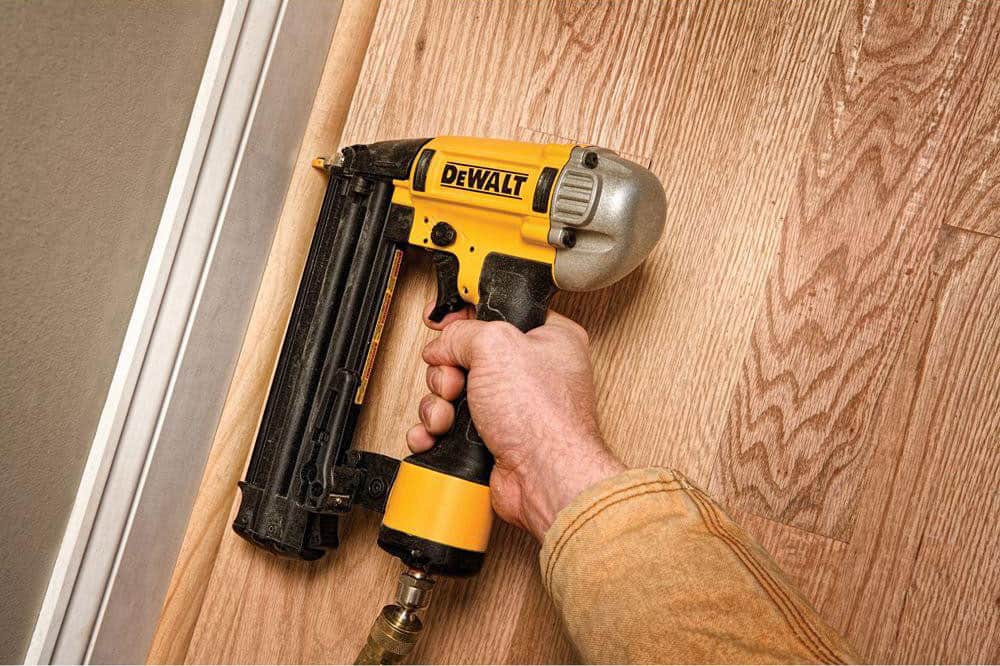
With the size of the brads and the nail gun itself being smaller, brad nailers can be very precise and allow you to drive the nail in exactly where you want it to go. That’s part of the reason why they are better to use for delicate materials.
They also make great entry points into the world of nail guns. It’s way easier to learn the ins and outs of a nail gun with a brad nailer, with their smaller size and lower delivery impact.
The first nail gun I ever bought was an 18-gauge 2″ pneumatic brad nailer that came in a combo kit with a pancake air compressor. Due to its smaller size, I was able to get more comfortable with how nail guns work. Once I got the hang of it, I didn’t feel so intimidated when I went to use a framing nailer for the first time.
Disadvantages of Brad Nailers
While there are clear benefits of using an 18 gauge brad nailer, they aren’t without their drawbacks.
Brad nails just aren’t strong enough to hold heavier and thicker materials. If you try to use a brad nailer to install thicker moldings like window trim, casing, or crown molding, you’ll end up disappointed with the final results.
They also have a hard time with certain materials, such as hardwoods and some thicker panel products like MDF and plywood. The small size of the 18-guage brads just don’t have enough holding power for these types of materials and sometimes aren’t even strong enough to penetrate the wood.
Pneumatic vs. Cordless Brad Nailer
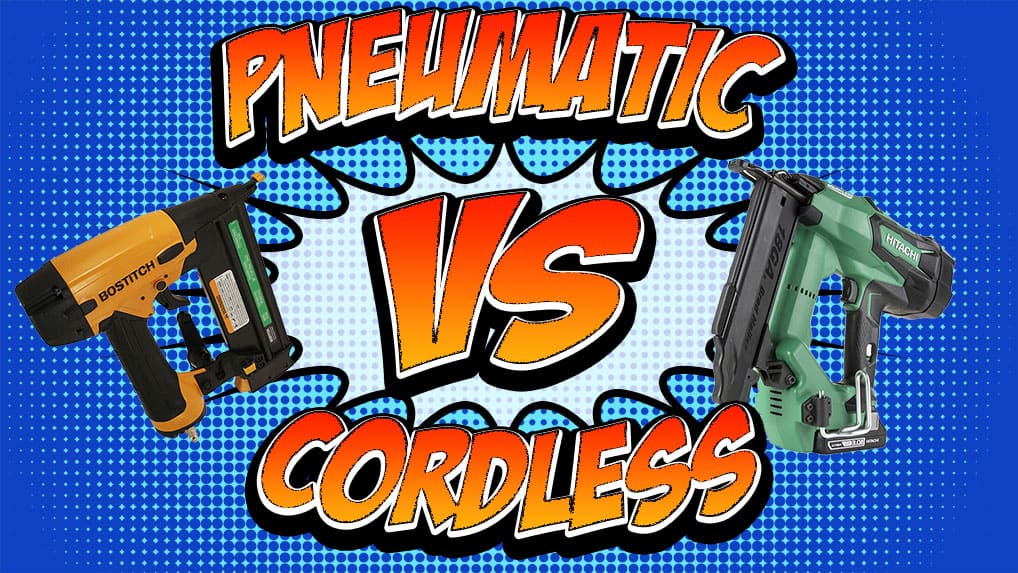
Brad nailers are available in both pneumatic and cordless models and they both have their pros and cons.
A pneumatic brad nailer is small, light weight and easy to use one handed. Since they need to be attached to an air compressor, your mobility is limited by how long your air hose is.
Cordless brad nailers give you more flexibility as you’re not tethered to a hose. Also, without needing to use an air compressor, they tend to be quieter than pneumatic nailers. However, the battery and the housing needed to power a cordless brad nailer make it bulkier and weigh 2-3x more than pneumatic models.
The bare tool (without a battery) cost of cordless brad nailers is typically 2-3x more expensive than their pneumatic counter parts. You’ll also need to have compatible batteries, which could be an additional cost. However, pneumatic nail guns do require an air compressor. That also adds to the total cost of ownership if you don’t already have one.
Another thing to keep in mind is the difference in firing cycles. Pneumatic nail guns fire as soon as you pull the trigger. Cordless models can take a minute to spin up before firing.
What do I prefer?
Both 😉
There have been certain jobs where a cordless brad nailer was more necessary and came in really handy. However, for most jobs where I need a brad nailer, I prefer to use a pneumatic one. Simply because they are so much lighter and fire as soon as I tap the trigger.
Can You Use Finish Nails in a Brad Nailer?
Nope. Finish nails are typically made at a thicker gauge and won’t fit in or shoot out of a brad nailer. It’s always best to buy the correct size of nails for the nail gun that you own.
How to Use a Brad Nailer
Using a brad nailer doesn’t require any special training or skills, but if you’re using a nail gun for the first time or are looking for some pointers, be sure to check out the following video:
What Is a Finish Nailer?
In a nutshell, a finish nailer is a nail gun designed for attaching finishing materials, like trim and crown molding, with finish nails.
Like a brad nailer, a finish nailer uses headless nails. That means there isn’t much of a hole size left over when the nail is shot. Smaller holes means you don’t have to use as much wood filler. Less wood filler means less sanding.
I don’t know about you, but I hate sanding. So, anything that reduces the amount of sanding is a good thing in my book.
The 15-gauge and 16-gauge nails that a finish nail gun shoots are thicker and stronger than brad nails, but not as big as framing nails. While a finish nailer is strong enough to use on pre-hung interior doors, you shouldn’t be building anything structural with them.
Most finish nailers will accept nails that range in length from 1 to 2.5 inches long. You just need to make sure that the nails that you buy are the right gauge. A 16-gauge nail gun won’t accept 15-gauge nails, and you can’t use 16g nails in 15-gauge finish nailers.
What’s a Finish Nail Gun Used For?
A finish nailer is the best all-around nail gun for most non-structural types of projects. As their name implies, they’re typically used to finish the job. Here’s some common projects where a finish nailer excels:
- Installing baseboard, crown molding, chair rails, and other types of trim
- Building cabinets
- Installing door and window casing
- Building staircases
- Installing hardwood floors
- Making furniture and other woodworking joinery
Advantages of Finish Nailers
Just about every finish nailer has the ability to set the depth that the nails are shot. That means there’s no need for additional tools, like a nail set, to countersink the nails.
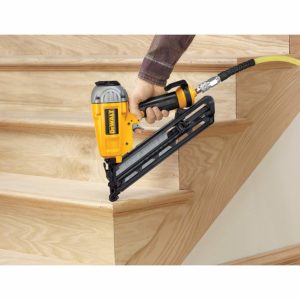
The headless nails leave small nail holes which require less filling and sanding.
Finish nails are much thicker nails are stronger than brad nails and make for a more permanent form of joinery.
The size and strength of 15-16 gauge finish nails make a finish nailer perfect for cabinet and furniture building.
A finish nailer is very versatile. It can be used with a wide variety of materials and surfaces, unlike a brad nailer, which can struggle with MDF and some plywoods.
Disadvantages of Finish Nailers
- Not good with thin delicate trim and materials
- The nail holes are small but will still need to be filled
- Doesn’t do the dishes.
16 Gauge vs 15 Gauge Finish Nailer
When I first started looking to buy a finish nail gun, I had no idea that they came in two different sizes.
I probably stood in the pneumatic tools section of the store for a good 30 minutes trying to figure out which one would be best for my needs.
And that’s what it really comes down to. Which finish nailer gauge is right for you?
In my case, I already had an 18-gauge brad nailer that I used for some small woodworking projects. I needed a finish nailer as I was in the middle of remodeling my basement and needed to install some baseboard, door and window trim, and door casing.
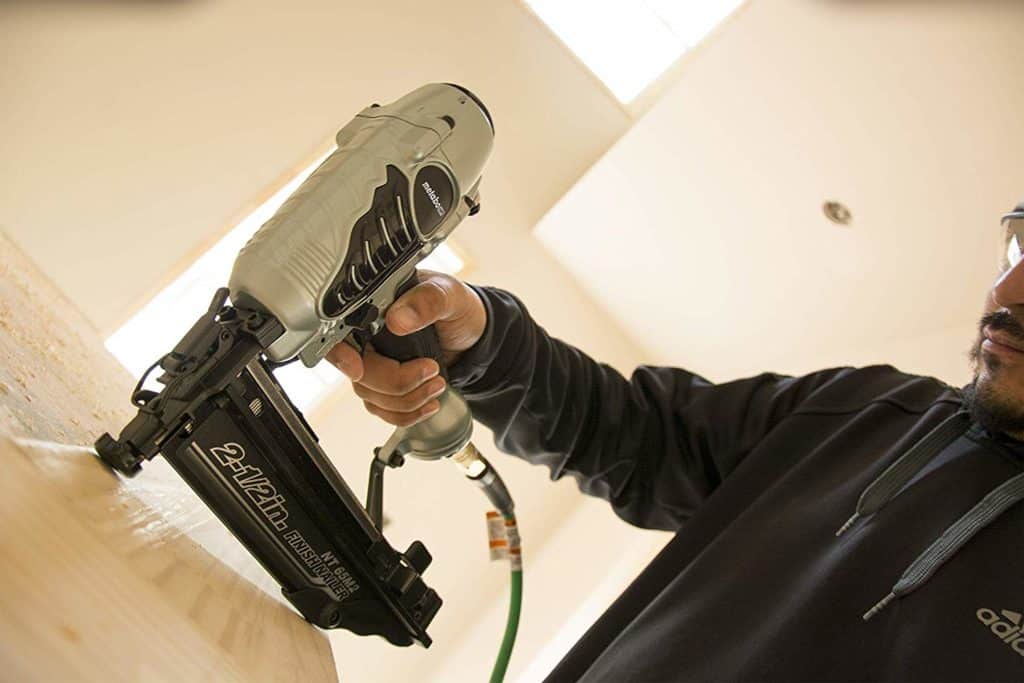
Since the brad nailer I already owned could handle installing fine molding, I decided that a 15-gauge finish nailer would be the best bang for my buck. In the end, I bought the Metabo HPT 2-1/2 In. 15-Gauge Angled Finish Nailer (Hitachi Power Tools is now called Metabo HPT).
Now, if I didn’t already have a brad nailer or planned on getting one in the future, I would have bought a 16-gauge finish nail gun. That would’ve allowed me to do most of the trim work I needed to get done and still be able to install some finer and thinner moldings, but at the risk of splitting the wood.
Like I said earlier, it really comes down to what’s the right tool for your job and your situation. There’s no right or wrong finish nailer gauge.
In the end, whatever finish nail gun gauge you ultimately decide on will get the job done.
How to Use a Finish Nailer
Using a finish nailer is no different than using any other nail gun, but the following video has some good tips that you might find helpful.
Summary
In the end, when it comes to age old debate of brad nailers vs. finish nailers, it seems pretty clear that brad nailers are perfect for delicate work and accents and finish nailers are great for thicker heavier materials like crown molding. For everything in-between, you can’t go wrong with either one.
If you’re looking to buy a finishing nail gun, and still can’t make up your mind between whether to buy a brad nailer or finish nailer, try to think about what kinds of projects you’ll be doing more of. If you’ll be doing more small woodworking projects like making picture fames, or building jewelry boxes, then you should probably go with a brad nailer, like this one.
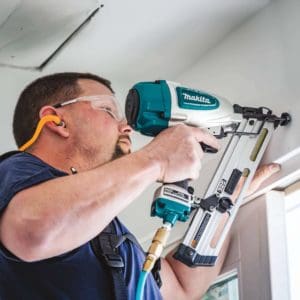
For more information on what brad nailer guns we recommend, make sure you check out our best brad nailers buyer’s guide.
Otherwise, if you plan on building some cabinets or other furniture, then a finish nailer would fit the bill.
If you don’t plan on buying a brad nailer, I would recommend getting a 16-gauge finish nailer like this one. Otherwise, I would recommend getting a 15-gauge nailer like this one.
Be sure to check out our finish nailer buying guide to see all of our recommendations.
FAQs
There’s no one-size-fits-all answer for this as “trim” can refer to a wide variety of finish moldings and materials. For door and window trim, you’d want to use a finish nail gun. For thin or decorative mouldings, you’d want to use a brad nailer.
When you want to attach baseboard to walls, it’s best to use a finish nail gun as 15g and 16g nails are thicker and have more holding power than 18g brad nails.
A brad nailer works great for attaching quarter round and shoe molding to baseboards.
When you’re installing crown molding, you’re fighting the forces of gravity, so you want to make sure that you have enough holding power to keep the crown moulding in place. 18-gauge brads aren’t strong enough, so a brad nailer is out of the question. Use a finish nailer.
The general rule for figuring out how long of a nail you need is done by measuring the thickness of the material you are trying to attach and adding an additional ¾ in. to 1 in.
For example, if the baseboard that you want to attach is ½ in. thick, you would want to use nails that are 1 ¼ in. long to 1 ½ in. long. Use longer nails for heavy-duty jobs like nailing door jambs, and shorter nails for attaching fine work like decorative trim and fine molding.
